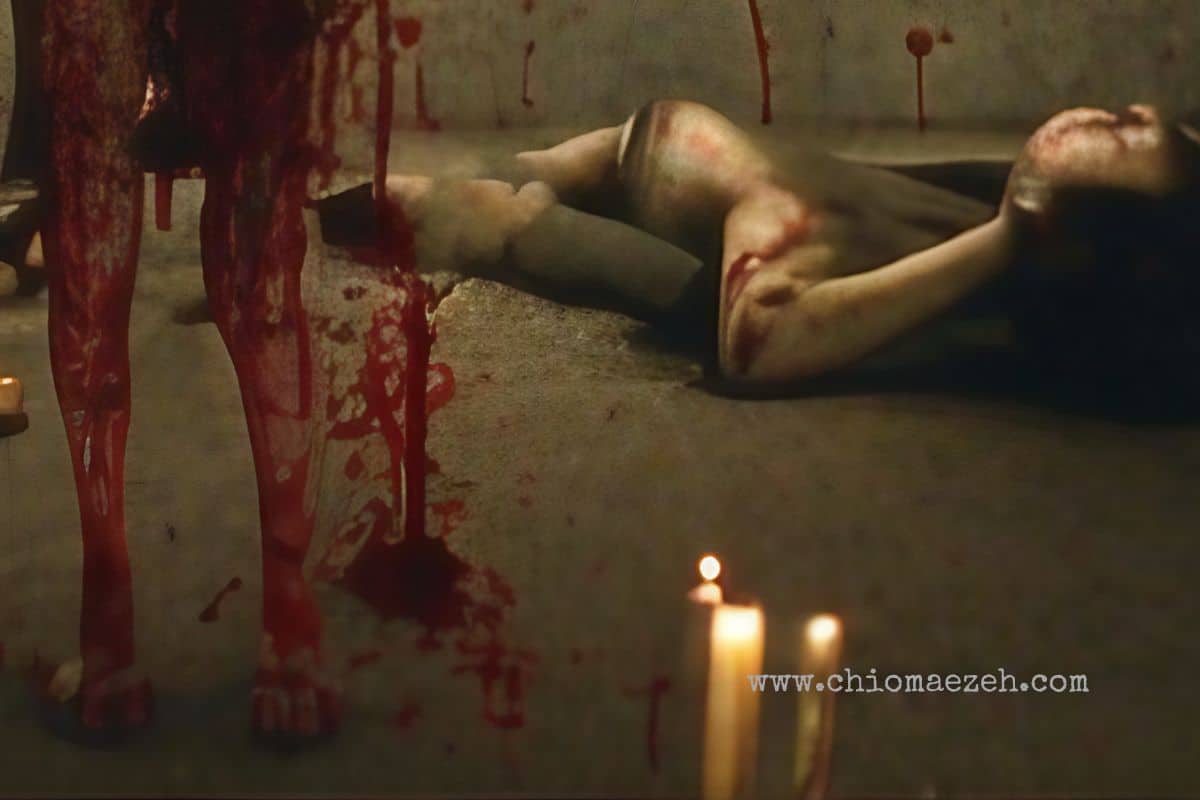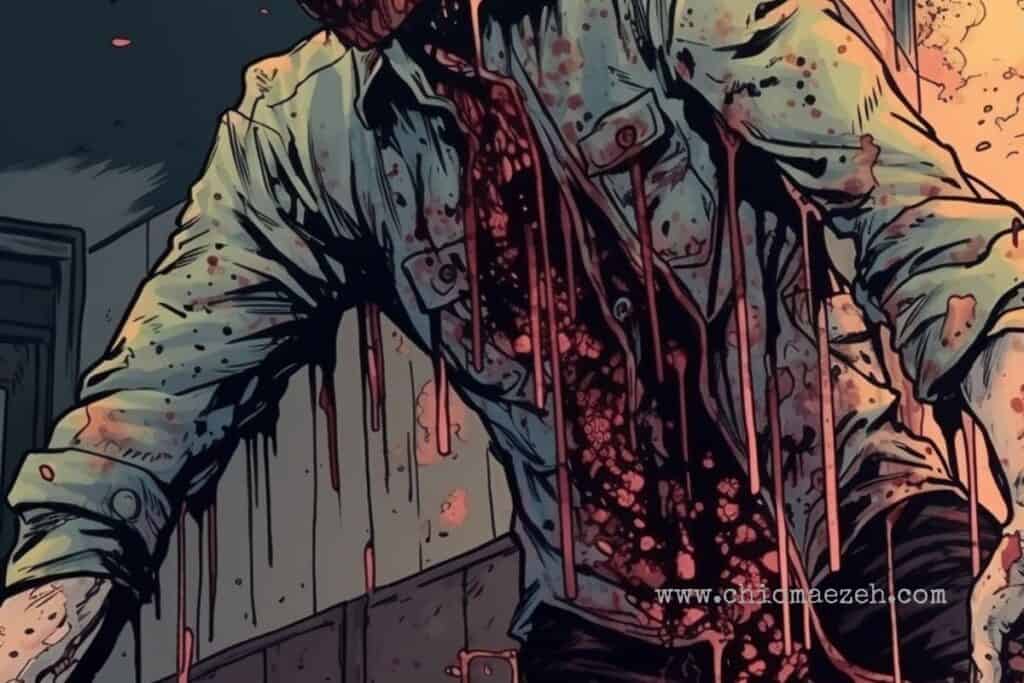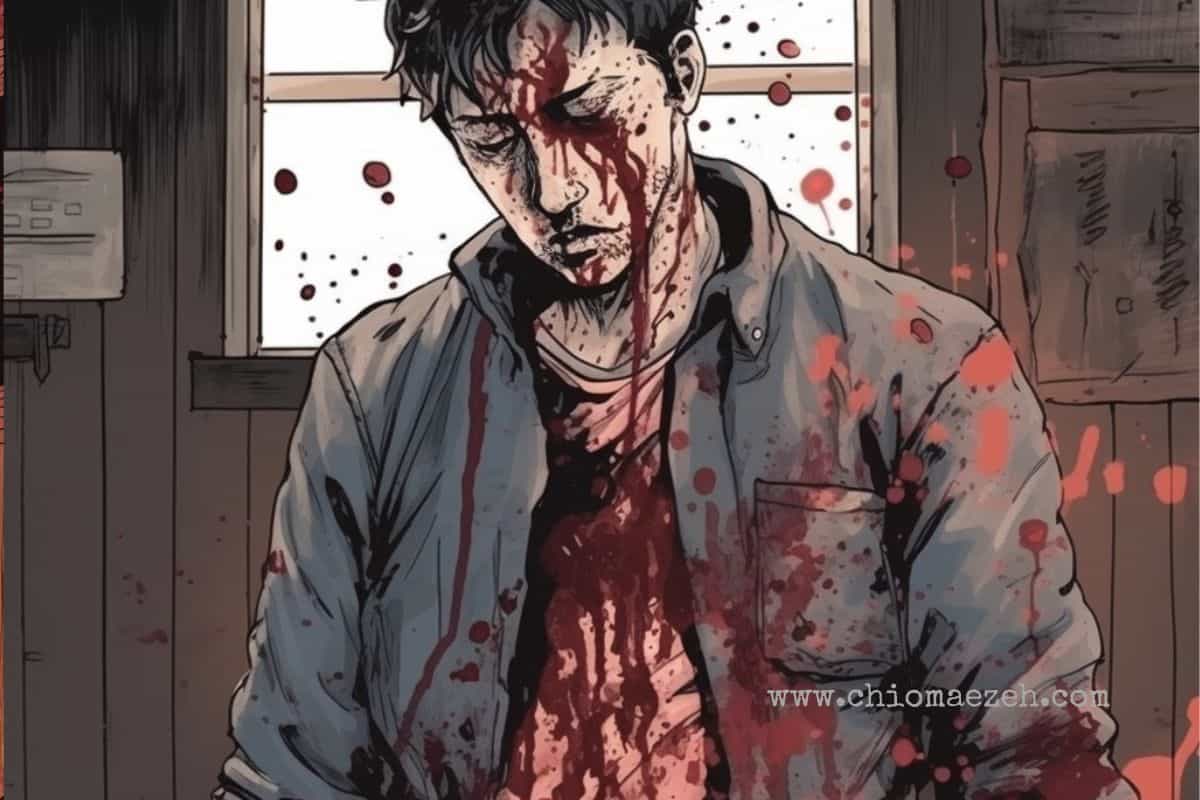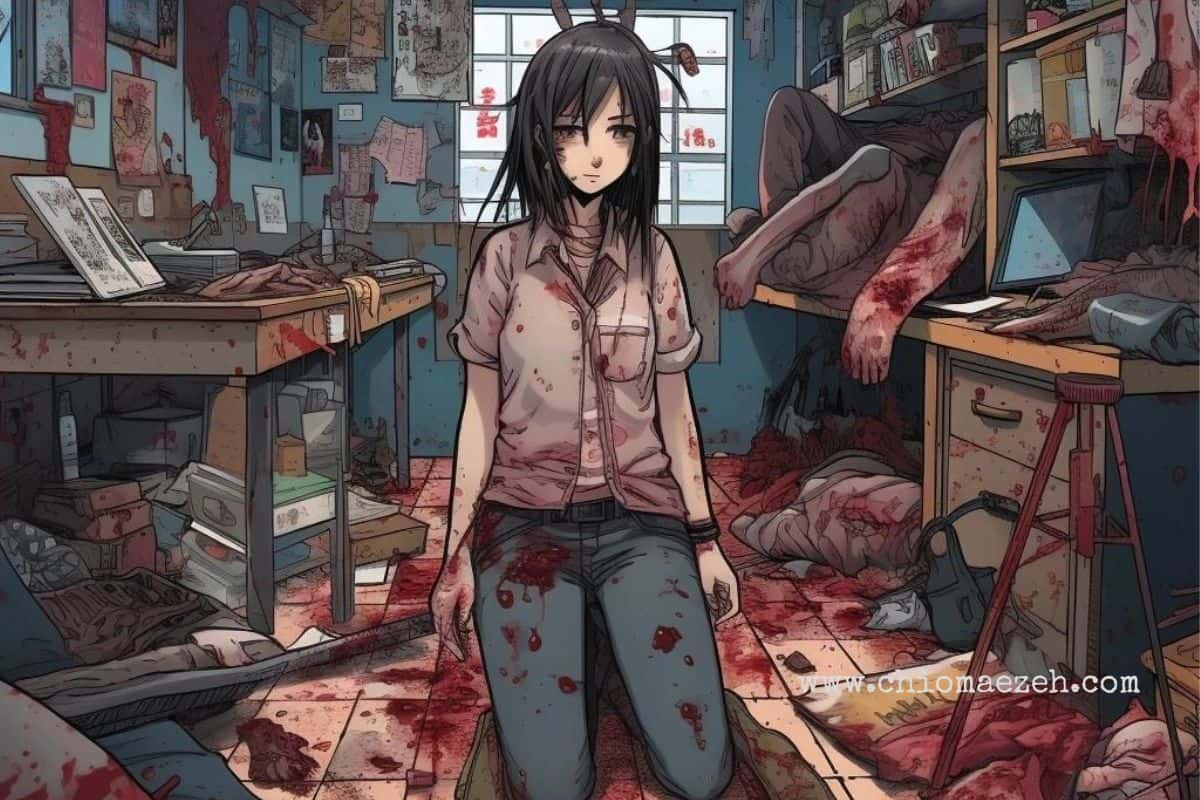What Is Gore In Horror Writing? [Definition, Examples]
Gore in horror stories means showing scary and bloody details to make the story more intense. It helps create a scary atmosphere and strong feelings for readers. But it’s important to use gore in a balanced way, so the story stays interesting and not off-putting.
Let’s explore gore and how it can be a helpful part of a horror story when used thoughtfully.
Warning: this article may contain sensitive, inappropriate scenes, imagery, or language.
👉 See our list of horror story ideas to get started

Let’s Talk
Are you a writer aspiring to pen a masterpiece that never fails to captivate? Look no further. Reach out to us and uncover how we can help you to take your writing to unprecedented heights!

What Is Gore In Horror?
Gore in horror refers to the explicit depiction of blood, bodily harm, mutilation, or other forms of extreme physical violence and trauma in a story or film. It is often used to evoke strong emotional reactions from the audience, such as fear, disgust, or shock.
Gore can be described in vivid detail, with a focus on the gruesome and visceral aspects of violent acts, injuries, or deaths.

In horror literature and film, gore is used to intensify the atmosphere of suspense, dread, and terror. It can heighten the stakes for characters and provide a stark reminder of the dangers they face.
While some horror fans enjoy the explicit nature of gore, others may find it overwhelming or off-putting. As a result, some horror writers and filmmakers choose to create suspense and fear without relying heavily on gore. Instead, they focus on psychological horror, atmospheric tension, or character-driven storytelling.
👉 See our list of scary story ideas and prompts
What Are the elements of gore in writing?
In horror writing, gore elements involve explicit and vivid descriptions of violence, physical trauma, and death. These elements are intended to provoke strong emotional reactions from readers. Some key elements of gore include:
- Graphic descriptions: Detailed and explicit portrayals of blood, wounds, mutilations, and dismemberment.
- Realism: Portraying injuries and trauma believably, even in fantastical settings, helps readers to better visualize the horror of the scene.
- Emotional impact: Evoking feelings of fear, shock, disgust, or empathy for characters experiencing or witnessing the violence.
- Suspense and tension: Eliciting dread and horror by making the consequences of violence more visceral and intense.
What’s The Appeal Of Gore: How Does It Impact The Reader?
There are reasons why some readers are drawn to horror stories with gory elements. You can use these reactions to engage them and create a compelling story.
Here are some of the psychological reasons why gore appeals to readers:
- Primal fear and curiosity: Gore plays on our primal fear of death and injury and a natural curiosity about our vulnerability.
- Catharsis: Gory events can provide a sense of catharsis that allows readers to experience and process intense emotions in a safe, controlled environment.
- Adrenaline rush: Gory scenes can trigger an adrenaline rush that creates a sense of excitement and anticipation in readers.
- Empathy and emotional connection: Gore can help readers empathize with the characters experiencing the violence and connect deeper with them.
- Exploration of darker aspects of humanity: Gore allows readers to explore darker aspects of human nature and confront their dark thoughts in a safe context.
The psychological impact of gore on readers can be significant – it taps into deep-seated fears, anxieties, and morbid curiosities.

How Does Gore fit into the overall horror story?
Gore can serve various purposes within a horror story and contribute to the overall experience. Here are some ways gore can fit into a horror story:
- Sets the atmosphere and tone: Gore can help establish a dark, unsettling atmosphere and set the tone for the story. It signals to the reader that they’re entering a world where violence and danger are present.
- Creates suspense and tension: Gore can heighten suspense and tension within a story by raising the stakes and reminding readers of the dire consequences characters might face.
- Enhances character development: Gore can reveal how characters react to violence and trauma. Their responses to gory situations can demonstrate their character strengths, weaknesses, and motivations.
- Advances the plot: Gore can act as a turning point or pivotal moment that drives the plot forward. It can be a consequence of the character’s actions or an obstacle they must overcome.
- Brings Authenticity: In some horror stories, especially those grounded in reality, gore can add a sense of authenticity and believability. It can make the story feel more grounded and impactful.
When used thoughtfully and purposefully, gore can be an effective tool in a horror story.
Should You Use Gore In Writing?
Whether or not you should use gore in horror depends on your creative goals, target audience, and personal preferences as a writer or filmmaker.

Here are some things to consider when deciding whether to incorporate gore into your horror project:
- What are your creative goals?: If you want to create an intense, visceral horror experience, gore can be an effective tool. However, if you aim to focus more on psychological horror, or character-driven storytelling, you may choose to minimize or avoid using gore.
- Target audience: Some horror fans enjoy explicit gore, while others prefer more subtle, atmospheric, or psychological horror. If you’re writing for a younger audience or those who may be sensitive to graphic content, be mindful of the level of gore you include.
- Personal preference: As a writer or filmmaker, consider your own comfort level with gore and the type of horror you enjoy creating. If you’re passionate about incorporating gore into your work, then, by all means, go ahead.
How you choose to use gore is subjective and depends on your creative vision, target audience, and personal preferences as a writer. As long as you use gore purposefully and rationally, it can be great for creating an engaging horror experience.
👉 See our article on how to write gore effectively
Example Excerpts Of Gore In Horror
Examples of intense and gruesome gore writing abound in horror fiction. Gore elements allow authors to use vivid and graphic descriptions to elicit strong emotions in their stories.
Here are three example excerpts from well-known horror novels that explitcly employ gore in an engaging way:
1. Example From Bret Easton Ellis’s “American Psycho”:
“He lifts the ax high over his head and I can see the muscles on his stomach, arms, and chest straining beneath his skin and he brings the blade down with a wet, sickening thud onto the side of her face, ripping through her cheek, and he does it again, cutting deeper, all the way down to her jawbone.”
2. Example from Chuck Palahniuk’s “Haunted”:
“As Saint Gut-Free, the man reaches both hands down his throat and begins to pull everything out. His stomach. His intestines. The man pulls out yards and yards of himself, twisting and wringing himself out, until he’s just a ragged sack of empty skin.”
3. Example from Bentley Little’s “The Store”:
“The man screamed and tried to pull away as the steel blade went in again, this time in his armpit, slicing through the thin layer of flesh and muscle, severing the brachial artery, blood spraying like a geyser.”
Popular Examples of Gore In Books And Film
There are quite several examples of gore from well-known horror novels or movies. Authors and filmmakers used gore effectively to create memorable and impactful scenes in these successful works. Here are four examples of popular books and movies that are impacted by gore:
Example 1: Stephen King’s “Carrie” (1974)
The Prom Scene: The titular character in this classic horror novel, Carrie White, is drenched in pig’s blood at her high school prom. The scene is a turning point in the story, as it triggers Carrie’s telekinetic powers and unleashes her rage on her tormentors. King’s vivid descriptions of blood covering Carrie and the ensuing chaos make the scene unforgettable. The gore serves as a catalyst for the story’s climax and emphasizes the consequences of bullying and cruelty.
Example 2: Thomas Harris’s “The Silence of the Lambs” (1988)
Hannibal Lecter’s Escape: In this psychological horror novel, the infamous cannibal and serial killer Dr. Hannibal Lecter, brutally murders two guards while escaping custody. Harris’s graphic descriptions of Lecter’s violent actions, including tearing off a guard’s face, are spine-chilling and shocking. The gore effectively shows the extent of Lecter’s ruthlessness and reinforces the danger he poses to both the protagonist, Clarice Starling, and society.
Example 3: Wes Craven’s “A Nightmare on Elm Street” (1984)
Glen’s Death Scene: Freddy Krueger, the antagonist in this horror film, invades the dreams of his victims, causing their deaths in the real world. One of the movie’s most iconic and gory scenes is Glen’s death, where he is sucked into his bed, followed by a massive fountain of blood gushing out. This scene demonstrates Freddy’s supernatural power and the gruesome nature of his killings.
Example 4: Clive Barker’s “Hellraiser” (1987)
Frank’s Resurrection: Frank is resurrected in this dark fantasy horror film after solving a mysterious puzzle box that summons sadomasochistic creatures called Cenobites. Frank’s resurrection is a gory and grotesque process, as his body is slowly reassembled from blood and viscera. This scene’s vivid and disturbing imagery is made more impactful by the practical effects used.
These examples show how effective gore, when used appropriately, can heighten tension, reveal character traits, and create memorable, impactful scenes.
Challenges With Writing Gore And How to Overcome
There are common challenges and pitfalls when writing gore. Many writers often make these mistakes when incorporating gore into their stories. Below are some common challenges and pitfalls when writing gore:
1. Overusing gore:
One common mistake is relying too heavily on gore, which can desensitize readers and diminish the purpose of gore. To avoid this, ensure that gore is used strategically and sparingly. Use gore to create an atmosphere of tension and horror without overwhelming the story.
Tip: Develop a sense of pacing, and use gore to build tension and atmosphere rather than as the primary focus of your story. Balance gory scenes with dialogue and world-building.
2. Using Gratuitous gore:
Including gore solely for shock value can come across as tasteless. It can detract from the story’s overall impact. Readers may disengage if they feel the gore is excessive or unnecessary. Ensure that every gory scene serves a purpose within your story – to reveal a character’s motivation, emphasize the consequences of an event, or heighten suspense.
3. Overshadowing character development:
Focusing too much on gore can take away from other crucial aspects of storytelling (such as character development and plot progression). Develop characters by showing how they react to and/or are affected by gore. Gore should only be included in a story to enhance the narrative and not to detract from it.
4. Unrealistic gore:
Creating unrealistic gory scenes can break the reader’s immersion and weaken the story. Imagine scenes like a character being shot with a gun and then having their body parts spilling out everywhere. This gore can take the reader by surprise and make it difficult to focus on the plot or the character’s motivations.
Research the realistic consequences of violence and injuries, and ensure that your descriptions of gore are grounded in reality, even if your story is set in a fantastical world.
5. Relying on clichés:
Relying on clichéd or predictable gory scenes can make your story feel stale and unoriginal. Popular cliches in gore writing include: over-the-top violence, generic monsters and creatures, guns blazing shootouts, and the “final girl” trope.
Though these tropes may be entertaining to some readers, most experienced horror fans know when a writer is going for shock value rather than providing an interesting story. Avoid using tired tropes and challenge yourself to come up with new and creative ways to depict gore in your story.
6. Inappropriate content for the target audience:
Writing excessively gory scenes for a younger or sensitive audience can be inappropriate. Be mindful of your target audience’s sensitivities, and adjust the level of gore accordingly. Consider using more subtle descriptions of gore, and focus more on the emotional impact.
7. Lack of emotional impact:
Merely describing gore without emphasizing its emotional impact on the characters can result in a weak and unengaging story. Focus on the emotional consequences of gore, showing how characters react to and cope with the violent events in your story.
👉 See our article on how to write gore effectively
Video Recommendation: Most Disturbing Gore Scenes
FAQs on Gore In Writing
What is gore in horror?
Gore in horror refers to the graphic and explicit portrayal of blood, violence, injury, and dismemberment in horror-themed media. It often serves to shock, disgust, or heighten the intensity of the horror experience for the audience.
Why is gore used in horror?
Gore is used in horror to evoke strong emotions such as fear, discomfort, or revulsion. It can also be employed to explore themes like vulnerability, mortality, or the darker aspects of human nature. Additionally, gore can function as a way to push boundaries and challenge the audience’s sensibilities.
Are there different subgenres of horror that feature gore?
Several subgenres of horror prominently feature gore. Some of these include:
- Splatter: Focuses on graphic violence and mutilation, often for shock value.
- Body horror: Explores the terror and revulsion arising from the human body’s transformation, disfigurement, or destruction.
- Torture porn: Centers on the extreme depiction of physical and psychological torture.
- Giallo: An Italian genre that blends horror and crime, often characterized by brutal murders and bloody visuals.
Is gore necessary for a horror movie or story to be effective?
Gore is not necessary for a horror movie or story to be effective. Many horror works use suspense, psychological terror, or atmospheric dread to create fear without graphic violence. Examples include films like “The Haunting” (1963), “Rosemary’s Baby” (1968), and “The Babadook” (2014).
How has the depiction of gore in horror changed over time?
The depiction of gore in horror has evolved with changing societal norms, advances in special effects, and the shifting tastes of audiences. Early horror films had to rely on suggestions and implications due to censorship restrictions. As these restrictions loosened over time, filmmakers began experimenting with more explicit gore, leading to subgenres like splatter and torture porn. Today, the use of gore in horror continues to evolve, with filmmakers balancing shock value with storytelling and thematic exploration.
Can exposure to gory horror content have negative effects on viewers?
Reactions to gory horror content can vary greatly from person to person. Some viewers may experience temporary distress, anxiety, or sleep disturbances. However, these effects are short-lived for most people and do not lead to long-term issues. Individuals need to be aware of their tolerance levels and choose horror content accordingly. Parents and guardians should be especially cautious when deciding if gory horror content is appropriate for their wards.
Final Notes: What Is Gore In Horror?
To sum it up, gore can make horror stories more exciting and scary when used correctly. It helps create strong feelings and keeps readers interested. As a writer, it’s important to use gore carefully to make your story enjoyable. By using gore well in your horror story, you can leave a lasting and spooky impression on your readers.

![6 Powerful Elements Of Dialogue Writing [Tags, Action Beats, Subtext & More]](https://chiomaezeh.com/wp-content/uploads/2023/03/Elements-of-dialogue-writing-768x512.jpg)



![What Is Point Of View In Literature? [Definiton, Types & Examples]](https://chiomaezeh.com/wp-content/uploads/2023/03/point-of-view-in-literature-768x512.jpg)
